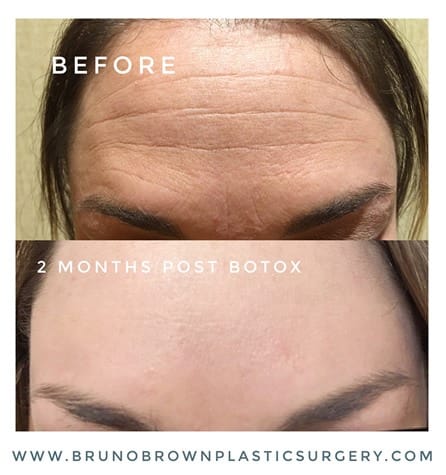 There’s a lot of misinformation out there about when to use Botox. We’ve heard and seen just about everything. Here, Dr. Brown sits down to answer the most common questions we get about Botox.
There’s a lot of misinformation out there about when to use Botox. We’ve heard and seen just about everything. Here, Dr. Brown sits down to answer the most common questions we get about Botox.
Q: When is the best age/time/signals you need to start considering Botox?
A:
As one might expect, people are very expressive, even in their sleep or just talking normally. The best time to start isn’t a specific age, but is when you notice that your expressiveness is leaving small creases in the skin.
It is easier to prevent than to correct, so patients are coming in earlier for preventative maintenance that keeps fine lines and wrinkles at bay for much longer. Coupled with good skin care and protection from environmental damage, the aged appearances of the past are becoming less frequent.
In our practice, most patients are in their 30s to 60s, with the bulk in the 40-55 range; I think it’s trending lower as more people realize it’s easier to prevent than to correct, so patients in their late 20s and early 30s are coming in, but maybe every 6 months instead of every 3-4.
Q: How should a patient consider using Botox in their 20s/30s/40s and so on?
A:
• 20s: It’s more preventative, so consider having it every 4-6 months
• 30s: You’re starting to correct wrinkles that show without moving, and these patients typically need it every 4 months
• 40s: This is more of a combination age, and these patients may need additional correction in the realm of skin care/PRP/etc; maybe having their eyes done and so forth to really help freshen the appearance
• 50s and up: This age starts to err more in the direction of correction (surgery) and Botox is more “icing on the cake” so to speak.
Q: Does it just work on the forehead and crow’s feet? Or are there other uses to consider?
A:
For me, the vast majority get it between the eyes and on the crow’s feet; next is the forehead and then ancillary areas such as the corners of the mouth, the bunny lines on sides of nose, neck bands and more. If you’re concerned about a particular set of wrinkles you’ve noticed and wonder if Botox is the right treatment, you should set up a consultation to discuss your specific needs.
Q: What gives some people the droopy eye and /or frozen look? How do you make sure you avoid having that happen?
A:
The tendency to treat fully the forehead lines allows the brow to drop, thereby giving the eyes a tired/droopy and frozen look. I go lighter on the forehead for this very reason; balance it with the elevation from the frown lines and the crow’s feet and it looks more natural.
Although we aim to get a perfect result every time, it’s often better to under correct as you can always add more if needed.
Q: At other med spas we’ve seen it as common practice to do big shots that leave us with a headache and the ‘mosquito bite’ telltale sign. Can you explain your approach?
A:
Every doctor has their own way but we use one of the smallest needles available and perform more precise injections in the muscle versus larger amounts; while there is always a chance to have a bruise or achy spot, using these techniques coupled with the application of ice minimizes our patients discomfort.
Q: How long do the results last?
A:
Results last about 4-6 months in certain areas, some people burn it off quicker; most patients return every 3-4 months.
We provide Botox to patients in the Washington, DC, Chevy Chase, MD and Norther Virginia area.
Are you interested in a consultation?
Click here!








